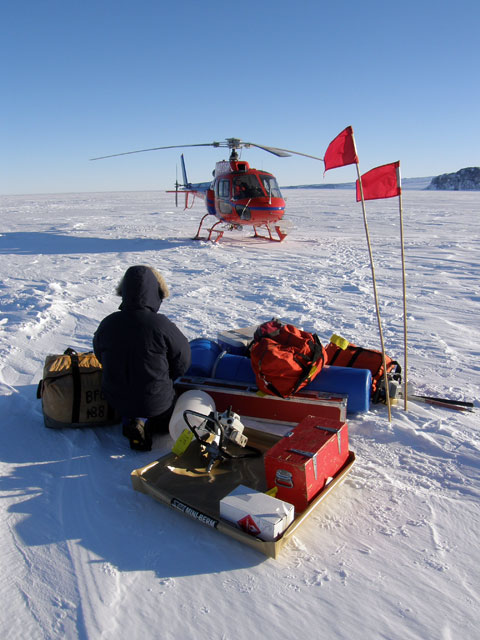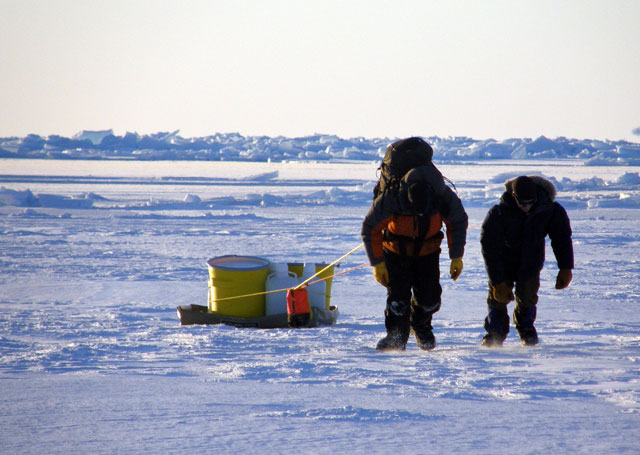|
Full bloomScientists collect frost flowers to test theory about windborne bacteriaPosted October 21, 2011
Collecting flowers to determine what bugs might be present would seem to be a pretty straightforward research project. But sampling frost flowers during the spring “bloom” in Antarctica to study the bacteria that inhabit the delicate ice structures is an altogether different job. Scientists from the University of Washington in Seattle The idea that these microbial bugs — squeezed out of the salty seawater onto these frost flowers that grow on top of sea ice — can catch a ride across Antarctica has all sorts of implications, from research into cold adaptations of extremophiles to the worldwide distribution of bacteria. “What we’re hoping to do with this pilot project is demonstrate that bacteria are, in fact, easily making the transit through severe conditions up in the troposphere,” said Jody Deming “If we can help advance that idea, then it has implications not just for polar regions but for tropospheric transport of bacteria all over the planet,” she added. Think of the child who blows on a dandelion seed head, dispersing the wispy white seeds into the wind, which carries them far and wide to find a place to germinate. Powerful storms may do the same with the frost flowers and their biological cargo, sending them upwards of a thousand kilometers to Antarctica’s glacial interior. Frost flowers are intricate structures composed of frozen atmospheric moisture and brine wicked from the sea ice surface, according to Jeff Bowman “The transport of brine into these structures means that they are unusually salty, up to five times the salinity of the ocean,” he explained on his expedition blog Deming has worked for about 20 years in the Arctic, where her team recently discovered that frost flowers contain bacteria, as part of an International Polar Year That prompted Deming to apply for a grant from the National Science Foundation’s Office of Polar Programs Bowman and Shelly Carpenter The extremely cold temperatures that still dominate during that time of the year are ideal for the formation of frost flowers, which require temperatures to be below minus 8 degrees Celsius. “We increase our chances of collecting them if we’re there during WinFly,” explained Deming, who did not accompany the team to McMurdo for its fieldwork. 
Photo Credit: Shelly Carpenter
A helicopter supports the Deming team near Tent Island on the sea ice.
Collecting frost flowers requires traveling from the station, located on the tip of Ross Island, to the edge of the sea ice where new ice forms near the open water. Unfortunately, the team was stymied in its first weeks waiting for the ice to become thick enough to safely work on. “The basic sampling strategy is to locate a safe place where the water is kept open by winds or currents … stand on the thick ice at the edge, and sample as the wind drifts the newly forming ice and frost flowers within reach,” Bowman said. In late September, the ice finally thickened enough to allow the researchers to collect their first frost flowers. Before then, Bowman and Carpenter attempted to grow them “artificially” by cutting holes in thicker sea ice away from the edge, hoping conditions would allow for frost flower formation. But a Weddell seal had decided the hole offered an ideal place to hunker down for a while, spoiling the experiment. However, with access to the ice edge, the researchers are able to haul back hundreds of kilograms of frost flowers, ice and water. “Out in the pack ice, where young [ice] is continually forming throughout the winter, the frost flower environment is impressively vast,” Bowman said. “Spatially, it’s much like looking out over a vast grassland.” 
Photo Credit: Shelly Carpenter
Sampling frost flowers is as easy as scraping them from the ice surface with a clean shovel into a sterile plastic bin.
Back in the lab, the scientists will analyze what DNA, RNA and proteins are present within the microbial community, according to Bowman. The DNA sequences tell them which bacteria are present and what metabolic processes they are capable of performing. The former is important for tracking the transport of the bacteria over distances. For the pilot project, the researchers will attempt to connect bacteria from the nearby McMurdo Dry Valleys to those found on the sea ice. “If we could document that bacteria are being transported that far, that’s a big step toward the larger question: can they be transported over very great distances,” Deming said. Another question is whether the transported bacteria are involved in any sort of biological processes within the glacial ice, an idea that motivates Bowman’s research. “Bacteria from frost flowers are already exposed to some pretty extreme conditions, so by the time they end up in glacial ice, they might be pretty well suited to continue to be active in the tiny liquid pockets in glacial ice,” Deming said. “Either they’re active themselves and contribute to various cycles in the ice, they become food for [other microbes], or they’re frozen in for a very long hibernation period,” she added. The RNA sequences tell the scientists which metabolic processes the microbes are currently using, while the protein sequences extend this concept further, telling them exactly which enzymes are present and active within the environment, Bowman said. “In this study, we are focusing on extracellular enzymes, which play a crucial role in polar carbon cycling and other processes,” he said. Analysis of proteins and enzymes from so-called extremophiles, organisms capable of functioning in the harshest environments, could offer insight into astrobiology, the study of extraterrestrial life, as well as life here on Earth. “Those proteins and enzymes might be of bio-technological or commercial interests downstream because they presumably can be active under extreme conditions,” Deming also noted. NSF-funded research in this story: Jody Deming, University of Washington in Seattle, Award No. 1043265 |



For USAP Participants |
For The Public |
For Researchers and EducatorsContact UsU.S. National Science FoundationOffice of Polar Programs Geosciences Directorate 2415 Eisenhower Avenue, Suite W7100 Alexandria, VA 22314 Sign up for the NSF Office of Polar Programs newsletter and events. Feedback Form |



